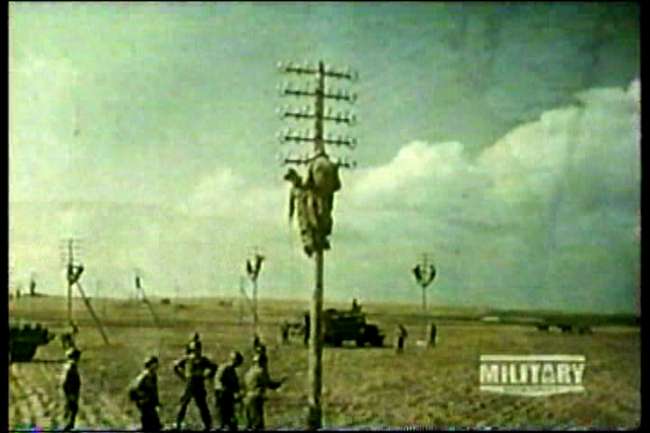WW II Signal Corps Linemen working in France - group view
By Steve McCollum; posted April 17, 2007
View Original (720 x 480) 273KB
 |
Saturday night I taped a half hour segment from The Military Channel's "World War II Battlefront." It was about the Red Ball Express, the truck convoy system that replenished the Allied forces after D-Day. One scene featured Signal Corps linemen restringing telegraph and telephone wires. This picture shows at least eight pairs of linemen working on poles, with one of the pair in the foreground pulling something up from the ground using a rope. It looks like they are reusing white porcelain insulators of European design. If anybody else can add more info, please let me know. Sorry for the poor quality of this frame. It was one of the best frames in that sequence. Many of the frames show dust, scratches, etc. on the original film. When you consider that this original film is over 60 years old, with its color faded by age, was MPEG compressed for transmission over DirecTV, decompressed and re-encoded to NTSC by my receiver, converted to analog video tape at low quality by my VCR, reconverted to video during playback, converted to MPEG again by my video capture box, edited, exported as a 720 x 480 BMP file, then contrast-enhanced by me, then converted to a JPG, then uploaded to ICON, then compressed by the Picture Poster, it's amazing to me that it is at all recognizable! For those interested, the original export of the 720 x 480 BMP file had no information in the 128-255 range. What's that mean? One form (of several) of the digital representation of a picture has each pixel encoded as three bytes representing amount of red, green, and blue in that pixel.. Each of these bytes can have a value of 0, meaning none of that color, to 255, meaning the maximum amount of that color. In the case of the grabbed frames, there was nothing in the 128-255 range of values for the three colors, making the contrast of the picture quite poor. Most photo-editing software provides the ability to do contrast enhancement. In this case, I used ACDSee to expand the contrast range of the pictures. Of course the missing information can't be restored, but the contrast range is now expanded, making the eye more pleased with the results. The complete 11 second segment can be seen at http://www.youtube.com/watch?v=RgNu1gvoR7I |